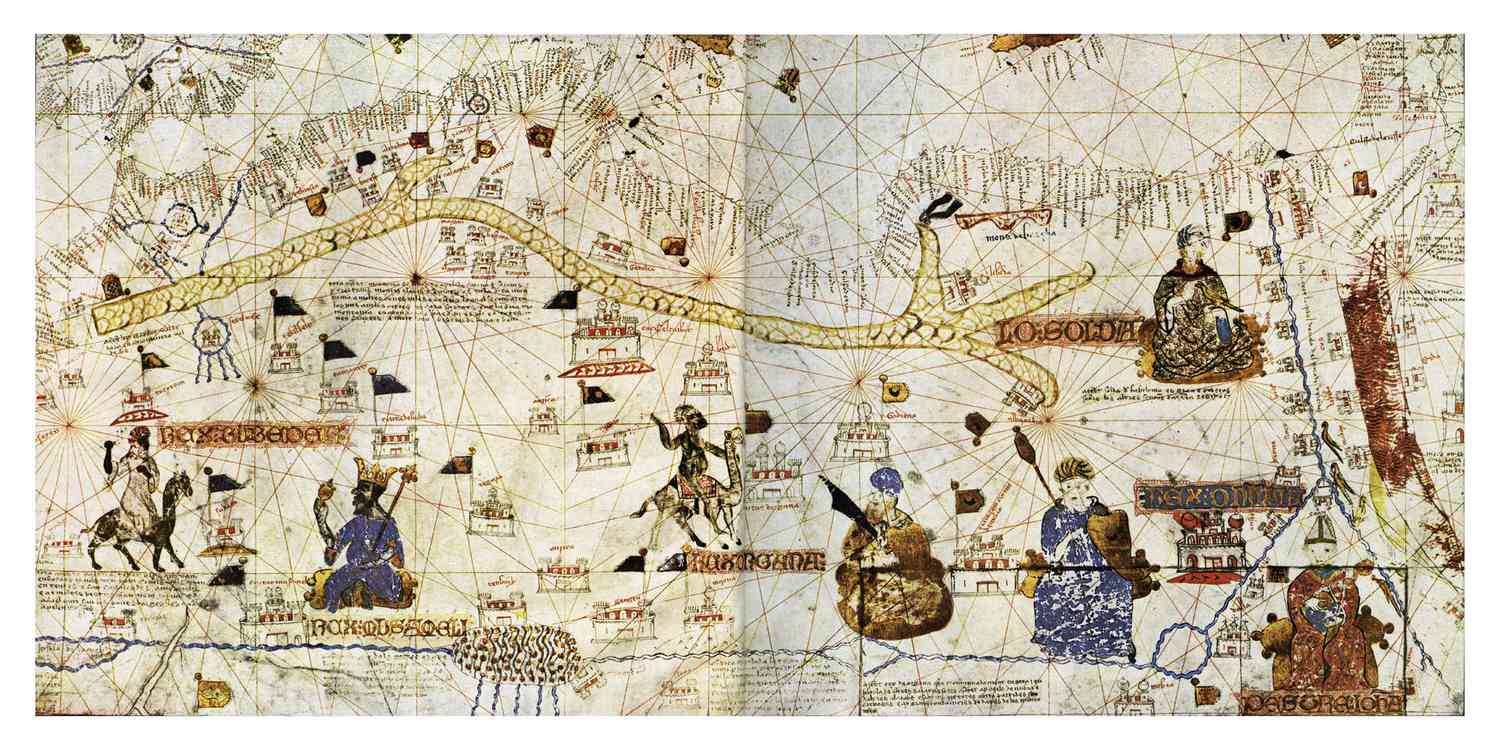Long before European imperialists arrived in Africa, the continent thrived on extensive trade networks that facilitated the exchange of gold, textiles, and ivory. These trade routes linked African merchants with traders from Asia and the Middle East, creating a sophisticated commercial ecosystem.
One of the most significant trade networks was the trans-Saharan route, which connected West Africa with North Africa and the Mediterranean world. This route fuelled the rise of powerful merchant empires such as Ghana, Mali, and Songhai.
Mansa Musa, the legendary ruler of Mali, commanded vast gold mines and controlled these lucrative trade routes. His 1324 pilgrimage to Mecca, accompanied by 60,000 attendants, famously flooded the markets of Cairo with so much gold that it caused inflation.
Prominent figures like Ibn Battuta, the renowned traveller, documented the wealth of Timbuktu and Gao, while Al-Maghili, a North African scholar and merchant, played a crucial role in economic and intellectual exchanges between the Maghreb and West Africa.
Gold from Mali and Ghana was highly sought after in Europe and the Middle East, forming the backbone of mediaeval economies, while salt from the Sahara was equally valuable, essential for food preservation and sustaining populations.
While the trans-Saharan trade dominated West Africa, the Swahili Coast—stretching from Somalia to Mozambique—flourished through its integration into the Indian Ocean trade network. Cities like Kilwa, Zanzibar, and Mombasa became vibrant trading hubs, attracting merchants from Arabia, Persia, and India.
Influential traders such as Sheikh Al-Amin Mazrui helped shape Zanzibar’s economic policies, while the Shirazi merchants from Persia established thriving commercial centers along the East African coast. The al-Mandhry family, prominent Arab-Swahili traders, controlled significant trade routes in the region.
African gold, ivory, and slaves were exchanged for silk, porcelain, and spices from China and India. Swahili merchants skillfully navigated these waters using dhows, traditional sailing vessels designed to harness monsoon winds.
In Central Africa, trade revolved around copper, ivory, and textiles, with the Kingdom of Kongo and Great Zimbabwe playing pivotal roles in regional commerce. Merchants from these regions engaged in trade with Portuguese, Dutch and Arab traders. Nzinga Mbemba, also known as Afonso I, the ruler of Kongo, attempted to regulate commerce while resisting colonial exploitation.
The Lunda and Luba merchants controlled the regional exchange of copper and salt, while Portuguese economic policies—shaped by figures like the Marquis de Pombal—significantly impacted African trade, particularly in Angola and Mozambique.
Despite Africa’s historical prominence in global commerce, colonialism disrupted its trade systems. The shift from balanced trade to raw material extraction and the transatlantic slave trade severely weakened African economies. European powers redirected Africa’s resources to fuel their industries, dismantling traditional trade networks and replacing them with exploitative colonial economies.
Much has changed since those pre-colonial trading days. The rise of digital commerce, fuelled by democracy and the Internet, has transformed Africa’s trade landscape. Countries like Nigeria, Kenya and South Africa have emerged as key players in global markets, with oil, cocoa, and cultural exports replacing the gold and ivory of earlier centuries.
E-commerce giants such as Jumia, Takealot, and Kilimall have revolutionised trade, enabling African entrepreneurs to reach international consumers. The growing demand for African-made products, from fashion to agricultural goods, highlights the continent’s increasing influence in global trade.
For too long, Africa’s trade history has been overshadowed by colonial narratives of dependency. Yet, the continent was once a global economic powerhouse, with merchants who shaped world trade for centuries.
The echoes of Mansa Musa, Swahili traders and Kongo merchants remind us that Africa’s wealth and ingenuity have always been central to global trade. Today, the rise of digital commerce and intra-African trade agreements signal a powerful revival of this economic legacy.
Africa was a thriving center of trade long before European colonization, with extensive networks connecting it to Asia and the Middle East. The trans-Saharan route linked West and North Africa, fostering powerful empires like Ghana, Mali, and Songhai. Ruler Mansa Musa of Mali famously shared his wealth during his pilgrimage to Mecca. Key figures like Ibn Battuta and Al-Maghili narrated the riches and cultural exchanges in regions like Timbuktu. The Swahili Coast's integration into the Indian Ocean trade network positioned cities such as Zanzibar and Mombasa as major trade hubs. Goods including African gold, ivory, and slaves were exchanged for Asian silk, porcelain, and spices.
Central Africa's trade with copper and ivory featured kingdoms like Kongo and Great Zimbabwe engaging with European and Arab traders. However, colonialism disrupted Africa's trade systems, specializing in raw material extraction and weakening local economies. Today's Africa has transformed its trade dynamics through digital commerce, with countries like Nigeria and South Africa becoming significant players in global markets. African entrepreneurs now reach international consumers through platforms like Jumia, reestablishing Africa's historic trade influence. Despite the colonial period's overshadowing effect, Africa's deep-rooted trade legacy, enriched by figures such as Mansa Musa, offers a narrative of resilience and innovation in the global economic landscape.






